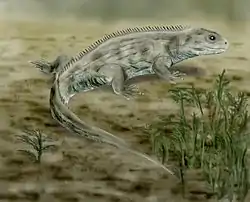Planocephalosaurus
Planocephalosaurus is an extinct genus of rhynchocephalian.[1][2] Fossils of the genus were found in the Tecovas Formation of Texas and the Magnesian Conglomerate of England.
| Planocephalosaurus | |
|---|---|
| Scientific classification | |
| Kingdom: | |
| Phylum: | |
| Class: | |
| Order: | |
| Family: | |
| Genus: | Planocephalosaurus Fraser, 1982[1] |
| Species | |
| |
Planocephalosaurus was one of the first sphenodonts and bore a strong resemblance to the extant tuatara, albeit much smaller, at only 20 centimetres (7.9 in) in length. The creature is presumed to have fed on large invertebrates and small vertebrates.[3]
Dentition
Planocephalosaurus exhibits very interesting dentition. Initially, it was believed to have been attached to the bone via acrodont tooth implantation, however, after this specimen was exposed to X-radiography it was determined that this animal has a combination of different tooth implantation types.[1][4] Similar to another rhynchocephalian, Diphydontosaurus, it possesses acrodont teeth in the posterior portion of the jaw, and pleurodont dentition in the anterior portion.[4] Planocephalosaurus's teeth were also fused with the cartilage, unlike its only extant relative the tuatara.[3]
References
- Fraser, N.C. (November 1982). "A New Rhynchocephalian from the British Upper Trias" (PDF). Palaeontology. 25 (4): 709–725.
- Fraser, N.C.; Walkden, G.M. (August 1984). "The postcranial skeleton of the Upper Triassic sphenodontid Planocephalosaurus robinsonae" (PDF). Palaeontology. 27 (3): 575–595.
- Palmer, D., ed. (1999). The Marshall Illustrated Encyclopedia of Dinosaurs and Prehistoric Animals. London: Marshall Editions. p. 85. ISBN 1-84028-152-9.
- Fraser, N.C.; Shelton, C.G. (1988). "Studies of tooth impantation in fossil tetrapods using high-resolution X-radiography". Geological Magazine. 125: 117–122. doi:10.1017/s0016756800009523.
